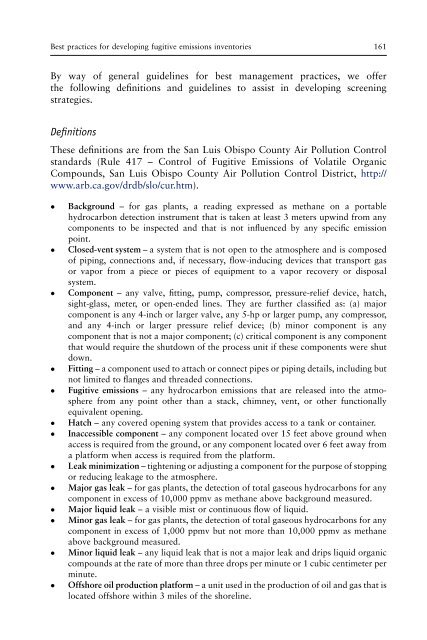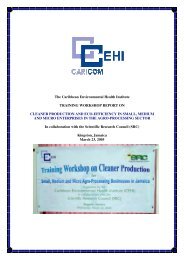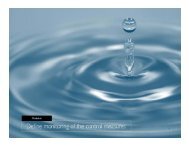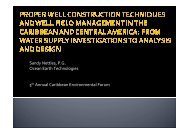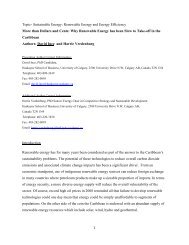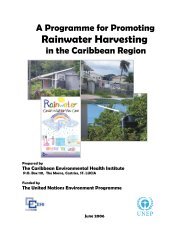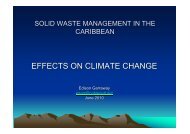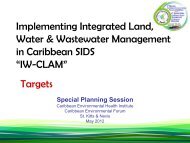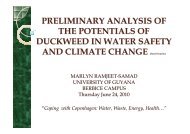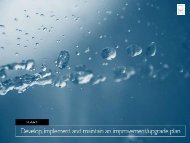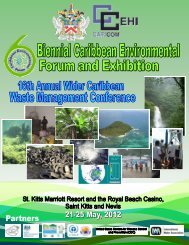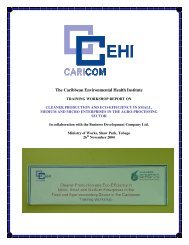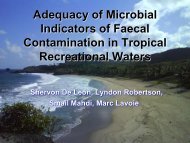best practices for the petroleum industry - Caribbean Environmental ...
best practices for the petroleum industry - Caribbean Environmental ...
best practices for the petroleum industry - Caribbean Environmental ...
Create successful ePaper yourself
Turn your PDF publications into a flip-book with our unique Google optimized e-Paper software.
Best <strong>practices</strong> <strong>for</strong> developing fugitive emissions inventories 161By way of general guidelines <strong>for</strong> <strong>best</strong> management <strong>practices</strong>, we offer<strong>the</strong> following definitions and guidelines to assist in developing screeningstrategies.DefinitionsThese definitions are from <strong>the</strong> San Luis Obispo County Air Pollution Controlstandards (Rule 417 – Control of Fugitive Emissions of Volatile OrganicCompounds, San Luis Obispo County Air Pollution Control District, http://www.arb.ca.gov/drdb/slo/cur.htm).Background – <strong>for</strong> gas plants, a reading expressed as methane on a portablehydrocarbon detection instrument that is taken at least 3 meters upwind from anycomponents to be inspected and that is not influenced by any specific emissionpoint.Closed-vent system – a system that is not open to <strong>the</strong> atmosphere and is composedof piping, connections and, if necessary, flow-inducing devices that transport gasor vapor from a piece or pieces of equipment to a vapor recovery or disposalsystem.Component – any valve, fitting, pump, compressor, pressure-relief device, hatch,sight-glass, meter, or open-ended lines. They are fur<strong>the</strong>r classified as: (a) majorcomponent is any 4-inch or larger valve, any 5-hp or larger pump, any compressor,and any 4-inch or larger pressure relief device; (b) minor component is anycomponent that is not a major component; (c) critical component is any componentthat would require <strong>the</strong> shutdown of <strong>the</strong> process unit if <strong>the</strong>se components were shutdown.Fitting – a component used to attach or connect pipes or piping details, including butnot limited to flanges and threaded connections.Fugitive emissions – any hydrocarbon emissions that are released into <strong>the</strong> atmospherefrom any point o<strong>the</strong>r than a stack, chimney, vent, or o<strong>the</strong>r functionallyequivalent opening.Hatch – any covered opening system that provides access to a tank or container.Inaccessible component – any component located over 15 feet above ground whenaccess is required from <strong>the</strong> ground, or any component located over 6 feet away froma plat<strong>for</strong>m when access is required from <strong>the</strong> plat<strong>for</strong>m.Leak minimization – tightening or adjusting a component <strong>for</strong> <strong>the</strong> purpose of stoppingor reducing leakage to <strong>the</strong> atmosphere.Major gas leak – <strong>for</strong> gas plants, <strong>the</strong> detection of total gaseous hydrocarbons <strong>for</strong> anycomponent in excess of 10,000 ppmv as methane above background measured.Major liquid leak – a visible mist or continuous flow of liquid.Minor gas leak – <strong>for</strong> gas plants, <strong>the</strong> detection of total gaseous hydrocarbons <strong>for</strong> anycomponent in excess of 1,000 ppmv but not more than 10,000 ppmv as methaneabove background measured.Minor liquid leak – any liquid leak that is not a major leak and drips liquid organiccompounds at <strong>the</strong> rate of more than three drops per minute or 1 cubic centimeter perminute.Offshore oil production plat<strong>for</strong>m – a unit used in <strong>the</strong> production of oil and gas that islocated offshore within 3 miles of <strong>the</strong> shoreline.


